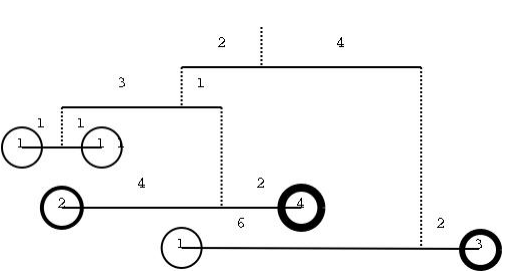uva-699 Not so Mobile (杠杆,巧妙递归)

| Not so Mobile |
Before being an ubiquous communications gadget, a mobile was just a structure made of strings and wires suspending colourfull things. This kind of mobile is usually found hanging over cradles of small babies.
The figure illustrates a simple mobile. It is just a wire, suspended by a string, with an object on each side. It can also be seen as a kind of lever with the fulcrum on the point where the string ties the wire. From the lever principle we know that to balance a simple mobile the product of the weight of the objects by their distance to the fulcrum must be equal. That isWl×Dl = Wr×Dr where Dl is the left distance, Dr is the right distance, Wl is the left weight and Wr is the right weight.
In a more complex mobile the object may be replaced by a sub-mobile, as shown in the next figure. In this case it is not so straightforward to check if the mobile is balanced so we need you to write a program that, given a description of a mobile as input, checks whether the mobile is in equilibrium or not.

Input
The input begins with a single positive integer on a line by itself indicating the number of the cases following, each of them as described below. This line is followed by a blank line, and there is also a blank line between two consecutive inputs.
The input is composed of several lines, each containing 4 integers separated by a single space. The 4 integers represent the distances of each object to the fulcrum and their weights, in the format: Wl Dl Wr Dr
If Wl or Wr is zero then there is a sub-mobile hanging from that end and the following lines define the the sub-mobile. In this case we compute the weight of the sub-mobile as the sum of weights of all its objects, disregarding the weight of the wires and strings. If both Wl and Wr are zero then the following lines define two sub-mobiles: first the left then the right one.
Output
For each test case, the output must follow the description below. The outputs of two consecutive cases will be separated by a blank line.
Write `YES' if the mobile is in equilibrium, write `NO' otherwise.
Sample Input
1 0 2 0 4
0 3 0 1
1 1 1 1
2 4 4 2
1 6 3 2
Sample Output
YES
题解:题意是让求这个杠杆是不是平衡;看了大神的代码,处理的很巧妙,如果当前质量是0,递归输入子天平,每个子天平判断是否平衡,就可以了;
代码:
#include<cstdio>
#include<cstring>
#include<cmath>
#include<algorithm>
#include<queue>
using namespace std;
#define SI(x) scanf("%d",&x)
#define mem(x,y) memset(x,y,sizeof(x))
#define PI(x) printf("%d",x)
#define P_ printf(" ")
const int INF=0x3f3f3f3f;
typedef long long LL;
bool solve(int &w){
int w1,d1,w2,d2;
scanf("%d%d%d%d",&w1,&d1,&w2,&d2);
int temp1=true,temp2=true;
if(!w1)temp1=solve(w1);
if(!w2)temp2=solve(w2);
w=w1+w2;
if(w1*d1==w2*d2&&temp1&&temp2)return true;
else return false;
}
int main(){
int T;
SI(T);
while(T--){
int w;
if(solve(w))puts("YES");
else puts("NO");
if(T)puts("");
}
return 0;
}
uva-699 Not so Mobile (杠杆,巧妙递归)的更多相关文章
- UVa 839 -- Not so Mobile(树的递归输入)
UVa 839 Not so Mobile(树的递归输入) 判断一个树状天平是否平衡,每个测试样例每行4个数 wl,dl,wr,dr,当wl*dl=wr*dr时,视为这个天平平衡,当wl或wr等于0是 ...
- UVa 699 The Falling Leaves(递归建树)
UVa 699 The Falling Leaves(递归建树) 假设一棵二叉树也会落叶 而且叶子只会垂直下落 每个节点保存的值为那个节点上的叶子数 求所有叶子全部下落后 地面从左到右每 ...
- UVA.839 Not so Mobile ( 二叉树 DFS)
UVA.839 Not so Mobile ( 二叉树 DFS) 题意分析 给出一份天平,判断天平是否平衡. 一开始使用的是保存每个节点,节点存储着两边的质量和距离,但是一直是Runtime erro ...
- UVA.699 The Falling Leaves (二叉树 思维题)
UVA.699 The Falling Leaves (二叉树 思维题) 题意分析 理解题意花了好半天,其实就是求建完树后再一条竖线上的所有节点的权值之和,如果按照普通的建树然后在计算的方法,是不方便 ...
- UVA 839 Not so Mobile (递归建立二叉树)
题目连接:http://acm.hust.edu.cn/vjudge/problem/19486 给你一个杠杆两端的物体的质量和力臂,如果质量为零,则下面是一个杠杆,判断是否所有杠杆平衡. 分析:递归 ...
- UVa 839 Not so Mobile (递归思想处理树)
Before being an ubiquous communications gadget, a mobilewas just a structure made of strings and wir ...
- 二叉树的递归遍历 The Falling Leaves UVa 699
题意:对于每一棵树,每一个结点都有它的水平位置,左子结点在根节点的水平位置-1,右子节点在根节点的位置+1,从左至右输出每个水平位置的节点之和 解题思路:由于上题所示的遍历方式如同二叉树的前序遍历,与 ...
- 【紫书】 The Falling Leaves UVA - 699 递归得简单
题意:给你一颗二叉树的前序遍历,空子树以-1表示,将左右子树的权值投影到一维数轴上,左儿子位置为根位置-1,右儿子+1求个个整点上的和: 题解:递归,整个过程只需维护一个sum数组. 更新根,更新le ...
- UVA 699 The Falling Leaves (递归先序建立二叉树)
题目链接:http://acm.hust.edu.cn/vjudge/problem/19244 #include <iostream> #include <cstdio> # ...
随机推荐
- 【转】 UIButton上使用UIEdgeInsetsMaketitle跟图片对齐
[转]http://blog.csdn.net/yanxiaoqing/article/details/7230660 默认情况下,不设置的效果,都使居中现实,button为150*150 使用以下设 ...
- Nginx模块开发入门(转)
前言 Nginx是当前最流行的HTTP Server之一,根据W3Techs的统计,目前世界排名(根据Alexa)前100万的网站中,Nginx的占有率为6.8%.与Apache相比,Nginx在高并 ...
- [Oracle] Listener的动态注册
在有Oracle Listener的动态注册之前,采用的是静态注册,所谓静态注册是指Oracle实例在启动时,读取listener.ora里的配置,然后注册到Listener,它主要有两个缺点: 1. ...
- Swift初体验(三)
/*******************************************************************************/ // 协议 protocol Des ...
- iOS 使用Method Swizzling隐藏Status Bar
在iOS 6中,隐藏Status Bar很的简单. // iOS 6及曾经,隐藏状态栏 [[UIApplication sharedApplication] setStatusBarHidden:YE ...
- [MOC062066]背景建模资料收集整理
一.相关博客 背景建模相关资料收集,各个链接都已给出. 资料,不可能非常完整,以后不定期更新. -----------------切割线----------------- 这个哥们总结的非常好啊,看完 ...
- 试用cmd markdown
欢迎使用 Cmd Markdown 编辑阅读器 我们理解您需要更便捷更高效的工具记录思想,整理笔记.知识,并将其中承载的价值传播给他人,Cmd Markdown 是我们给出的答案 -- 我们为记录思想 ...
- Ajax或JS动态添加的元素,Jquery效果不起作用
问题: 最近在做一个Ajax分页的功能,遇到一个问题 一开始jquery效果是可用的,但是,ajax执行一次之后,jquery效果就无效了. 解决办法: 可以添加live事件来解决 W3C关于live ...
- Deep Learning(深度学习)学习笔记整理系列之(三)
Deep Learning(深度学习)学习笔记整理系列 zouxy09@qq.com http://blog.csdn.net/zouxy09 作者:Zouxy version 1.0 2013-04 ...
- C++11多线程
这篇文章说的很详细: https://www.ibm.com/developerworks/cn/linux/1412_zhupx_thread/
